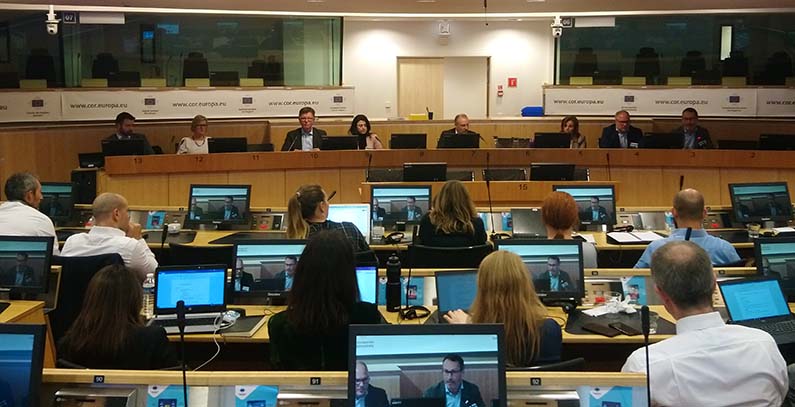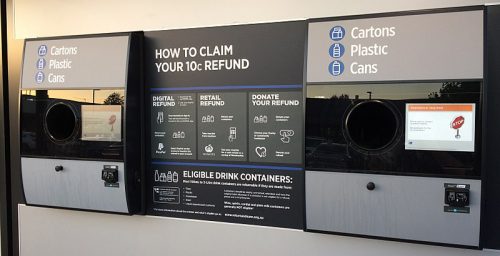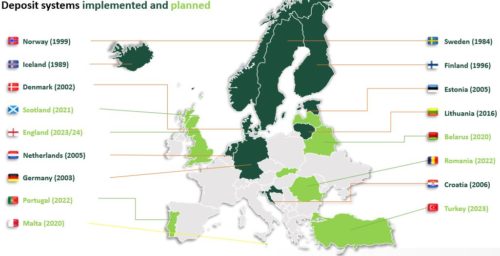
Photo: BGEN
The deposit is not the goal in itself, Andrè Van de Nadort asserted in Brussels on November 21. Speaking at a conference on the return systems for single-use beverage containers, he stressed the focus is on reusing packaging as circular products. Van de Nadort is the mayor of Weststellingwerf in the Netherlands and the rapporteur of the European Committee of the Regions’ (CoR) opinion on the European Plastics Strategy. The institution hosted the event.
The gathering was organized by Reloop Platform and the European Federation of Bottled Waters or EFBW, with the aim to get representatives of governments, operators, experts, producers and technology providers together to discuss the best-in-class deposit return systems or DRS for single-use bottles and cans and other containers for beverages.
EFBW’s Deffis: Conservative lobbies are still working against change in handling beverage containers
Jean Pierre Deffis, the federation’s president, told the audience that it aligned all members last year to pledge they would reach the collection rate of 90% for polyethylene terephthalate (PET) through 2025. He noted the European Union’s Single Use Plastics Directive set the mandatory target at 77%, which needs to climb to 90% by 2029. According to Deffis, “conservative lobbies” are still working “against change.”
PET bottles at top of list in litter on European beaches
The document entered into force in July and the transposition into EU members’ national law is scheduled to take place in 2021, said Bettina Lorz from the European Commission’s Directorate-General for the Environment. She pointed to research results showing PET bottles and caps and lids are the biggest item by count in litter on European beaches while that drinking cups and lids are in the eighth place. The ambition is to develop a standard where tethered caps and lids would be attached to the plastic packaging, the senior expert explained. The goal, seen within five years after the introduction of the directive, would include sizes of up to three litres.

She noted the original proposal by the 28-member bloc’s executive arm was to get to a 90% rate for recycling by 2025. The requirement for the level of recycled PET in new packaging is 25% by 2025 and 30% of recycled content in all plastic bottles by 2030.
Start in recycling must be at local level
Regions are key for solutions leading to a plastics-free society and to get to the root of the issue, the start must be at the local level, said Brune Poirson. The French secretary of state to the minister for the ecological and inclusive transition Élisabeth Borne spoke in a prerecorded video message.
Deposit systems for beverage containers result in high collection rates as well as high-quality material for recycling and they cut the carbon footprint by three tenths, in the words of Anna Larsson, head of circular economy project development in Reloop. She showed data that revealed the scheme gets the level to at least 85%, where Germany tops the list in the EU with 98% retrieved. In some countries, thanks to deposit systems, the PET loop is already closed, she claimed.
Not moral to make profit from problem
Alessandro Pasquale, chief executive of Mattoni 1873, warned that the activity is not yet at a circular level and that not all packaging units are being returned. In his words, policymakers and the industry don’t need to “invent anything special” but to identify the most effective examples. The Czech-based company and PepsiCo Inc. took over Serbian water and beverage producer Knjaz Miloš this year.
It “is not moral” to profit on the problem, Pasquale claimed. However, he expressed the opinion that circular economy is “financially sustainable” and that in time it could do more than just break even.

The CEO went on to urge more support from the EU, governments and local authorities. He stressed politicians are not used to working towards compromise. The Mattoni boss suggested circularity can be achieved via the five components of the company’s approach. The deposit scheme should be centralized and colours would be harmonized, for instance to have only five, he underscored. Pasquale said the remaining factors would be for beverage producers to retain ownership of the materials, that they must be returned to them and that a complete food grade quality recycling is warranted.
Beverage production can be the most circular in the world with only 10% new material, CEO of Mattoni 1987 Alessandro Pasquale claims
The Italian executive said the sector can be the most circular in the world with only 10% new material. He rejected the so-called downcycling option, where used packaging is used for the manufacturing of other products, like textile.
Director general of Brewers of Romania Julia Leferman highlighted the fact that the Eastern European country would have the largest centralized deposit return system in the continent when it is introduced.
Packaging retrieval enables value creation
Lawyer Remo Klinger said there are no general obstacles to the introduction of a deposit system. Mirroring the assessments by several other participants, the partner at Geulen und Klinger from Germany pointed to the significant material value of beverage packaging and the value creation due to the bottle-to-bottle recycling.
Bengt Lagerman, general manager of Sweden’s operator Returpack, reminded the audience that his country introduced deposits already in 1984 after the introduction of aluminum cans. The law was adopted already in 1982 amid worries that littering would surge, he added. The privately owned entity consists of Returpack-Burk Svenska AB and Returpack-Pet Svenska AB.

The executive said 94% of volume goes through retailers while that 95% is recycled. Of note, Lagerman asserted, much of the remainder is taken across the border by Norwegian shoppers.









Be the first one to comment on this article.